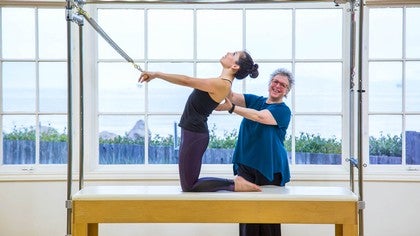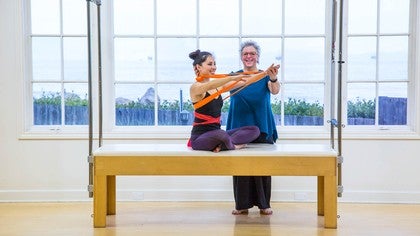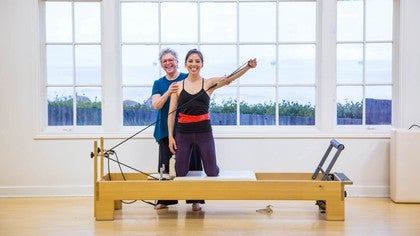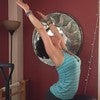Description
About This Video
Transcript
Read Full Transcript
Hi, I'm Leslie Pow and I'm going to be teaching an embodied anatomy reformer class. I'm going to go to use the imagery around the shoulder girdle. And the one thing I want you to really think about is a lot of what we've been doing in shoulder stability is locking the shoulder down. And so what I want you to think about throughout this practice is here's the shoulder blade and that when she lifts her arm up, that shoulder blade needs to slide with her hand. And in in my a training Irma guard Bartanian called it the hand scapular relationship. So the more we get the shoulder blade to move, that's when we're going to invite better mechanics as well as if you look to the front, uh, there you go.
Is that when she lifts her arm up, we also want to get that clavicle wide. And so the more we find that with of the shoulder girdle, the better mechanics we're going to have involved. So what I want you to really see, you might have to make the movement smaller is is your shoulder blades wide on your back and clavicles. I would rather you go for this movement then for letting the shoulder blade narrow across the back. So the first thing we're going to do is you're going to come in facing to the um, reformer and we're going to start some rotator cuff awareness and building a strength. Now I'm keeping it very light.
I'm only on a yellow spring and you wanted make sure that if it's too heavy, heavier spring and they start getting into their shoulder blade, they're not going to get to the rotator cuff. So you're going to bring your arm up and she's gonna put bend her elbow and she's going to bring her arm to the tip, a shoulder blade. That shoulder blade is now on upward rotation. She's going to bring her elbow forward and she's going to place her hand lightly. This is from my teacher, Irene doubt. She's going to visualize her humeral head lightly coming back into the socket.
Like you have a little tiny snap and you just snap it back into place and then that Scapula is going to go wide to her elbow. She's going to squat down and put her elbow on to the box and she's gonna lightly pressed the box forward. That's it. She can take the other hand off. And now without changing the spawn, she's going to do internal rotation. And then she's going to do external rotation. So there's a little bit of load, but it's, she's doing a great job because that shoulder blade is staying, um, very wide. And then she's gonna bring the carriage back home and she's going to come back up to standing. So remember, will any of this rotator cuff, we wanna be that much work. She's going to bring the other arm up, she's going to bend her elbow, she's going to bring the tip of the shoulder blade, she's going to bring that arm down.
You're going to plug that humeral head lightly in the socket, get the Scapula wide, she's gonna Squat down and put the elbow down. Great. And she's, and if you need to squat down more, that's fine. And it's more about, that's fine. No more than that. And now she's going to move her head that in. So she just has a little bit of low, just a little bit of resistance. And she's doing internal and external rotation. If she put her other arm underneath the armpit, you, she could feel the subscapularis working and then she's going to bring the carriage back home and bring the whole thing back in. That's great.
Now put both elbows on and your hands Kinda kind of face and put it towards there. Just a little bit awareness and, and Serratus. So she's going to do sternum drop. She's going to widen the tip of the shoulder blade away, and then she's gonna push the carriage away and lift the elbows up and she's gonna just slide the trapezius lightly down into her top. And then she's going to bring the whole thing back in. And you're going to do sternum drop. You're gonna push off and Wyden, she's gonna push the carriage forward. And it's all about, again, working for that stability.
There's just a little bit of lightness of that lower trapezius. But again, it's that much. It's getting all the coordination woken up when we do more advanced work and push out and bring it through. Great. That's great. Now come up to standing and face to the forward and we're going to talk about this superspinatus. So the superspinatus comes up through here and its helps rise our arm up so her palm starts facing towards whore hips and she's gonna gradually reach out and the tips of the shoulder blades reach out. Now it's really important that you find as much with from the Scapula to the pinky and the thumb, the clavicle to the thumb.
And then she's going to rotate and she's going to bring it up. Then her shoulder blade stays high and her back and she's going to slowly lower the arm down without changing her clavicle or shoulder blade so that she wakes up her superspinatus and then bring the arm back down. Let's do that one more time and then we're gonna put it on to the, the machine rotate, bring the whole thing up and throat. She's gonna lie Supine, her hips up against the shoulder rest
And we're also gonna talk about the importance of training the throat to improve posture. So we're going to have her do cervical nod to start training the neck. So she's going to bring her chin to Adam's apple. This is really important for posture cause a lot of our clients are living here, which affects the shoulder girdle and come back down and lift up and she's doing a great job because she's not using her shoulders and then she's going to do the same pattern that she did standing. So her palms are facing towards her and she's gonna gradually open out to the side. Her arms are above her body. Then she's going to rotate and take her arms out to a v.
There you go. Then she's going to run the slowly and her shoulder blade and clavicle stays wide and bring it through. She's going to press out, she's going to rotate and bring it up. You can bring your head just a little bit back down. There you go. So kind of want to have the head in line with the spine. I'm not interested in flection. Last one, bring the whole thing back up and then rotate and bring it through. Right.
Nice. Great. And now we're going to have her come to sitting facing first towards the front and the post steer a cuff muscles are and realize all the Pa, the rotator cuff muscles attach just to the shoulder blade. So there's no reason you should be add ducting pulling the shoulder blade down. So it's like she's opening a door. So she's with a straight arm, straight arm opens and that's all I want. And now she's going to close the door and not let it slam and she's opening out and notice I'm doing really tiny reps and very light just to wake things up before we start the whole workout. There we go. That's great and good.
Okay, turn around. And so here is her that post to your cuff and she's going to open out clavicles wide. Let your shoulder blade be, she's pulling down a bit. So we want to make sure the shoulder blade is beautifully wide and we're just trying to wake up those muscles of your rotator cuff muscles. Great. There we go. And one more time. There we go. Nice. Great. Okay, so now let's have you lie on your back and we're going to have you, um, do supine arms.
I did read a one red spring. Again, I'm always looking at is I don't load the arms up until I know they can get the shoulder blade in the correct place because if the load is too heavy, they're going to be more likely to press down. Bring both legs up into a chair pose. There you go. So we're gonna start her off bringing her arms right over. So she's already in a load. And remember when we started the session, we want to start that whole thing of that humeral head lightly going down into the socket. But the tip of the shoulder blade is going up. You're gonna slowly bend both elbows without moving your humerus bone and then you're going to slowly straighten your arms.
So a lot of times when people straighten the arms, they add shoulder girdle going forward. So we're just trying to wake up the tricep to extend the arms and then press out. Wonderful. Then keeping that humeral head lightly in that socket. Can she press to mid thigh again? I'm only going to go to the place that she can keep her with of a shoulder girdle and then bring the whole thing back up.
What you really want to get target that they stay in their tricep throughout the whole movement. There you go. And then you're going to come back up and then she's going to bring her arms down and hold. There you go. And Now Ben, both elbows. There we go. Great. And press out. Now she could, we could leave right into coordination, but I'm still keeping that humeral head lightly out. So she's going to press out into the a hundred position. There we go. And let's keep your shoulders down open and close your legs and then bend your elbows and come through.
And the reason I'm asking her to keep her head down is I don't want her to add her shoulders to do that movement. But we're going to then let's do straighten your arms. Go to the a hundred position, keep your shoulder girdle Watt, lift your head up, keep your shoulder girdle. Why come up a little higher without cheating. That's what we like. There you go. And then bring the whole thing back down and bring it through.
Great. So we're gonna build it into, um, footwear. And I kind of put this as a, uh, give you an idea about the coordination of your core. So that's your anterior slang and your, and here is sir. Sling is connects from your serratus to your external oblique to your internal Blake. And that Chris Cross is going to get her better. So I want her to bring her hands like so she's gonna widen her elbows apart and she's gonna think of how we did when we were here.
I'm still going to see my shoulder blade slide around and then I'm going to feel that beautiful crisscross as I push out and straighten the legs. Wonderful and then slowly come back home. That's great. And push out great. And so this is great because getting this sling is putting her ribs in a really great place because a lot of times people are pulling down in their backs and this Chris Cross is going to solve a lot of issues of hyperextension. Great. Nice. Nice, good.
Now put your arches on and I'm going to bring this down. One load come up, bring your legs up and I want you to put your arches on. And now I want you to bridge up. Send your pelvis over the foot, bar gray, push out two thirds stay. Keep that with of your shoulder blade without moving the carriage slowly lower down, widen. And now see the sashes slide longer even though they're still working. There we go. Great. And now you're going to bridge back up.
There you go. Lift up. Nice and without moving the carriage. Slowly roll down, let the sashes slide longer. But they still have tautness against your pelvis and spine. Nice and lower down and last one, lift up and then bring the whole thing back up and through. Great. And then you're going to lower the whole thing back down and let it go. Great.
So now we're going to have her come up and we're going to look at Mermaid Leslie Pals version. So let's have you come into the mermaid position. And the first thing I want you to do is put your left hand right there. And I want her to think about those shoulder blades being one on her back. Sometimes I'm just going to ask her to turn her hip towards the foot bar and then she's going to come back and through and she's doing a great job because a lot of times your clients are not moving from their lower um, spine and they kind of try to push it from their upper spine and the more we can get the spine to have freedom and support, it also will support the shoulder blade. That's great. That's great. Good.
Now put your left hand on here. And the first thing we're going to do is a lot of times when you see people do a lot of side arm work is they push out and they do downward rotation. Of the shoulder blade. So can she keep that beautiful width and push out and straightened her arm? Just that, that's it. And then come back home and when she's, she's doing a great job. When she's doing it, she's really working from her tricep. That's great. And then come back through.
Then she's gonna push out. It's kind of a version of Cleopatra. So I want you to push the rest of the carriage away with your hip and she's going to keep her clavicle wide so her ribs are sliding around that wide shoulder blade and then she's going to bring the whole thing back up. That's great. And you're going to push out and widen. There we go. That's great. And then push through and then come back.
Good. Now we're going to add on. You're going to push out and we did the thing with the superspinatus so she's going to reach her arm wide. There you go. She's going to rotate and up and go up and over. There we go. And then she's going to bring the whole thing back and through. I'm going to ask her to bring their, her gesture are more forward.
Go ahead and reach and bring this up. And so that that shoulder blade wraps around the ribs. And then I want her to get a little more of that sash coming in and then come back and bring it through. Now bring your left arm back here. So we're, I call this excersice mermaid. So push out and put your hand on your breath, your right hand on your breastbone. So we're gonna do it first at this level, the then up high and then up high.
So she's going to push out a little bit more with her hip. There we go. She says she's going to turn her head, she's going to turn ahead. She's going to turn her ribs and she's going to feel that shoulder blade, the ribs slide around that watch shoulder blade. She's gonna turn her head. Turn your head. There's the exercise part. There you go. And then you're going to bring the whole thing back. So push out and reach.
And what's neat about this is a lot of times people are rotating from their shoulder girdle. And when you start your head leading, it really invites real abuse. Shuffle spinal rotation and come through. Now let's have you push down out more. So she's going to go a little lower. It's going to stretch her little differently. Exercise, turn your head, turn your head, look over your shoulder. There you go. Look up to the ceiling. No, the round, the, I'm sorry. There you go. Up, up, up and keep turning.
Keep turning. Beautiful. And then come back up. Now you're gonna add your arm with the excersice. Right. Here you go. Reach out wide. There you go. Go up and over and now turn your head. Turn your head. Thread your arm underneath. There you go. Turn your head first.
Turn your head first. Bring the whole thing back. Wide shoulder blade. There we go. And come back up. Beautiful. Okay, now you get to see her back to come around. That was nice. Good. So she's gonna put her arm, uh Oh yes. Put your hand there. Just move a little closer there. So she's going to turn her hip, which is inviting some real nice movement down in her sacrum.
And her lumbar and sometimes people are really stuck there. There we go. That's what you need to do in walking. There you go. Great. Good. And then come back up and you're going to put your hand right smack in the middle. She wants to get that shoulder blade wide. Clavicle wide. Push out. Just your arm. There we go. There we go. So she ca we can get it a little wider. There we go.
And then can she keep it wide and catch the work? Coming home. Bend your elbow, come back home and push out and widen. Scapula reaches the elbow to the hand and then bring the whole thing back. Now you're going to push out. You're going to move the carriage away with your hip. There you go. Nice. Nice.
Nice, Nice. It's great. And then bring the whole thing back. Wonderful. Wonderful. And do one more plane and then we'll add the arm. Go ahead. There you go. Nice.
She's going to have much more success right now being a little bit, having the hand peripherally so she can see it and then she's gonna bring it back. Now I want her to think of that sling coming in so that when she pushes out, that doesn't get too long. She's just going to visualize those sashes staying in place. There we go. Nice. Nice, Nice. And then bring the whole thing back. Bring your arm to the back edge and you're going to push out and good. You can lean just a little bit.
Put your hand on your breastbone and you're going to turn your head. So we want to get those ribs to rotate around that wide shoulder blade. Then she's going to look up to the ceiling and keep going. Keep going, keep going. Keep going. And there you go. And grade and push out Scapula, elbow hat. Go ahead. Nice. And then push out. Turn your head, turn your head.
Nice. Nice. There we go. And then you're going to bring the whole thing back. Turn your head. There you go. And through, now she's going to add her arms. She's gonna reach out. Push out first. There you go. She going to still bring her arm a little forward exercise.
Turn your head, turn your head by turning her head so much. It will get her arm underneath. Turn her head. Bring the whole thing back up. Lift. I'm going to back her up to, cause she wants to uh, lose her. Beautiful shoulder blade. Good. One more time. And reach. Go. There you go.
And then you're going to bring this and there you go. Great. Beautiful. Beautiful. And just keep that wide and turn your spine. There you go. Beautiful. That's great. Good. Okay, now we're going to have to come to quadruples. So come to your hands and knees. This is kind of a variation of many different exercises.
But um, so the first thing she's gonna do is she's gonna bend her elbows and I want her to have a flat back. So here's her s wide shoulder blades. Remember when we started the, the session on the box, she's gonna push out and she's going to get that tip of the shoulder blade. And then she wants to push out a little more. And leaned more into there. There you go. Stay that low. Bend your elbows. Think of what you did in supine arms. There you go.
She's doing great. She might need a little here, but not much. That's great. And then come back home and then push out and hold. Great. There you go. Then she's going to see she has a beautiful scapula connection. Push out with your legs. Now she needs to keep these and here sling going.
Bring your legs back home. Good. And push out. Good. No more than that. That's fine. Just a little bit. There you go. And push out. Hold. Now I want her to round her back, but keeping the west so she needs around right through there. And we're going to ask her to lift all these ribs up. Beautiful. And then go back to flap back or extend cat.
And so what I'm doing here is I'm pushing out so she doesn't use her hip flexors, so it's really teaching her to stay in her beautiful shoulder blades. And then she's using her core gray and now she's going to go to down stretch. So she still wants to see those shoulder blades. She's got to move that in and lift up. Then push back out. Keep the tip of the shoulder blades rapping to the hand.
There we go. Bring the whole thing back in. Wonderful. Press the whole thing back and through. There you go. Great. Last one. And then you go to come up. Great. Now we're gonna do some versions of chest expansion. So face, um, and this version, I like to have the feet off the uh, edge. So just to review, she's gonna bring her on her arm forward.
Yeah. And she's going to bellow her elbow out to the side. So what I want to have you do is to have the humerus bone in line with the scapula and then she's going to open her forearm in line with her humerus belt and then bend your elbow, bring it in all the way and you can bend a little more. Yes. So it's kind of like a version of a chess rolling, but she has to really use her core, um, legs and core. So she's going to bellow her elbow out to the side a little more. Like it's an Elbow Jab. Yeah. Thank you.
And then she's gonna keep that and open her forearm out. There you go. So she's working that whole post your line and then she's gonna bend her elbow and bring it in. Great. And Elbow Jab out. Reach the forearm out. There you go. And then you're going to bring it back. Looks easy, but she's working and there you go. Grey. We're going to do the other side.
What she's doing now. Think of your humerus bone lightly. Come back into the socket, bellow your elbow out to the side. Stay. Feel your elbows. Reach away from the tip. Then move your forearms away from your shoulder blade. Nice. Bend your elbows. Come back in and bring it through. And you can straighten your elbows.
Just let it go. Bellow. Feel that whole post your line work. There you go. Open your four arms out. Nice. Nice. Nice. Bring the whole thing back in and take it through. Good. Last one. And you're going to open out lift. Lift up your breastbone. There you go.
There you go. Great. And then you're going to bring the whole thing back and through. Good. Now she's going to face, um, sideways. We're gonna do sword up on your knees. Very good. Draw a sword.
So same idea. Uh, let's just do it once because when you're going to open your elbow out in line with your Scapula, you open your forearm in line with your humorous bone hand, and then she's gonna bring the whole thing across tore and she can bring it down to get her sword again. Okay. There we go. So again, I want her to lift up. I want her to think of that anterior sling lifting. There's even a little bit of the post here. There we go. Float your clavicle up open. There we go. And she's going to bring the whole thing back and through. If some people, um, in some machines don't have a yellow, some people need to work on this strength so she could use her right hand as an assist that she needed, but she's doing pretty good. And here we go.
That scapula stays wide open, the forearm lift, and then she has to really stay in that posterior cuff. And there we go. Wonderful. We're gonna have you turn around. Let's just do the, uh, choreography again. So here we want her to keep her shoulder blade wide open the forearm if there, and then her wrists and then she, we want her just to keep that wide and come across. He got it. So bellow the elbow out, bring the forearm in line with that and wrist, and then the whole shape comes down as one postier down.
[inaudible] that's it. There you go. There you go. Good. Great. There we go. And one more. There we go. Great. Okay, good. So now we're gonna do chest rowing front again. I, here's the, um, I'm going to work on a yellow and we're doing, oh, I didn't tell you we're doing chest rowing, front kneeling, I'm sorry.
And I love, you know, the beauty about kneeling work is it really teaches you to get your core and your standing and your legs together. I keep it very light at first until I know how they can handle it. The catch 22, when it's lighter, they have to work their core more. Let's just bring your arms here first and remember how we started the session where we want that humorous bone to lightly come back. But the tip of the shoulder blade moves there.
We're going to do a version of tricep press, but I want her keep her arms parallel so it'll be a little different. Now come back down to kneel, squat. And there you go. And slowly with control come up. Before we even begin, you're gonna just, let's run, I'm going to call it my mantra, humeral head. Lightly back tip of the shoulder reaches forward, you're going to press up and you're going to keep lengthening your first rib up.
So a lot of times when people straighten their arms, they do this. So you need to keep dad up and bend your elbows. Wonderful. Great. And you're going to push out and you're going to keep your clavicle up nice. And then come back down. There you go, got two more. That's it. That's it. Great. Nice, good and great and great.
Now she's going to come back to Neil's the squat and bring the um, uh, straps. So the straps are in, so the thumb will be on the inside. Now what I love about this exercise is when she stretches her arm up, it's kind of the line where the shoulder barely to be sliding. I want her to open her arm out only to where she can keep her shoulder blades wide and then she's gonna come back and then she's going to squat. So bring your elbows or right away, push so that they're in line with your, uh, forward more. There you go. And then come up to kneel. Stand and now think Scapula, elbow, hand float your clavicle up. Reach. Now just stay there.
See the tip of the shoulder blade. Reach more as your clavicle. Clavicle gets wider. Open your arms out only to the place you can keep the shoulder blades wide and then you're going to bring the whole thing back. Tips of the shoulder blades move to your hand and then bend your elbows and squat down. Nice. Beautiful, good. And you're going to go up steps. Think Kat Scapula, elbow head.
Let your f your clavicle float and open out to the side. Great. And then bring the whole thing back home and then bend the whole thing back and bring it down. Wonderful. Last one with, we're going to add a variation. I'm sorry. Reach up and hold. She's going to keep her rights scapula wide and she's going to open our left arm out to the side. There you go. Lift up your first red.
She's going to bring both arms back in and then she's going to take a bow. Thank you so much. There you go. And you're going to reach up. The Bose shoulder blades have to stay wide even though one lessons work that I would call that the gesture arm. Both scapula's stays wide, Ben. Both elbows come back home. Good. One more time and reach. There you go. Good.
And Open your arm out. Tip of the shoulder blade broadens to each hand. Nice. Come back home and then bring it back home. Great. And last one. Good. There we go. Great. Great, great, great. And then, there you go. Wonderful. Great, great.
There we go. Great. That was nice. Great. Okay. Doing a good job. So we're gonna have her come. Um, I'm going to have you come so that, um, you're good to have your forearms on here and your fingers there and you're a feed there. Uh, uh, let's do red, yellow, and she'll tell me how that is. Okay. So here again is this serratus work that we're working and I love working sometimes on forearms because you can't, if you have a lot of mobility in your arms. So she's going to go to downward dog and she's gonna send the tip of the shoulder blades to her hands. She's going to push out to plank pose. Tell me if that load is okay. Is it okay?
And she needs to get more legs and lengthen or breastbone forward. Then she's gonna use her arms to shoot her tailbone up with her new slang. There you go. Now push harder with your arms. Oh, that was great. Now push harder to send your tail up, but not your ribs. There you go. Push back to plank pose. Fly your breastbone.
Forward your sit bones to your heels. Nice. Then drive your forearms down to send the tail up to the ceiling. More forearms, more forearms. Lengthen. Good. One more time. Press out. There we go. There we go. Great. There we go. And then you're going to bring the whole thing back. Tip. There you go. Great.
Wonderful. Wonderful. And Great. Good. Okay, so now we're gonna come to elephant. Um, I'm going to do, um, red blue and we're gonna first start out in flat back elephant. So I'm gonna kind of bring in the same thing that we talked about on the forearms. So we're gonna have her do sternum drop and we're going to get the tip of the shoulder blade to move towards the foot bar. She's going to do a cervical notch. Hinter Adam's apple. There we go. Shoulderblades come together, sternum drop and then she's going to push off and widen.
Now energetically I want her to energize her hand to think of lifting the breastbone equally to the ceiling. The whole breastbone. The breastbone goes from the first rib to the bottom. 10th maybe you know eighth. Now she's going to push out a little bit with her legs. Great. Good.
Just like we did annealing I w without moving the carriage. She's going to hinge back at her hips, but she's going to keep her wide shoulder blades. She starting to lose it so I want a little more at serratus. There we go, and now she can give me a little more slang. There you go. And then shift the whole thing follower without moving the carriage. Good. Sternum drop. Push off and widen.
There we go. You're going to send the whole thing back. Good. Nice. Keep that lift. There we go. Now stay there. Chin to Adam's apple. She's going to push out with her legs. She's only coming back one inch. There you go. There you go. And push out.
So I like to keep the legs working the whole time so they can't cheat and use her hip flexors. Thank you so much. Good. Now just as we did Neil, and she's going to push out a little bit and I want her to round her, her lumbar, and then I want her to lift up through her here, but I, that's beautiful. So a lot of flection, this is beautiful. Equal reflection. A lot of people lose their serratus and go back into extension. Flat back, lengthen. Great.
And then you're going to go back and go into a good start, lowers first, and then lift the first rib. That's it. And then bring the whole thing back and through. Good. We're going to have you come to a up stretch that load. Okay for you. So we're going to watch what she does. Ah, so again, we're gonna first do it in neutral because I want to really see that she has that shoulder blade connection right now.
I want her to shoot her shoulder a breastbone forward as she goes to plank pose. Shoot, and that you legs backwards, but lift this up. There we go. Then keep this lift and send the tail to the back of the room to come into downward dog. Now she's moving more from her lumbar, and so here's where that, and here's sling is gonna work. She's going to go to plank pose. I'm her like the the stork. Yes, dropped out, and then this add sling should bring it all together. That was beautiful. Nice. That's great. And go forward.
Good. Great. Now shift forward. We're going to do two more traditional. She's going to keep us a radius and flex right through here. Just up here. Then here, then here, then push out back to downward dog. Downward dog with your new slick note. Flat back. There you go.
And go out plank pose. Clavicles good. Give me a little more legs down. There you go. Shift forward. Chin to your Adam's apple. Cervical. Nod the first rib, second rib, third rib, Lumbar, then push out to with good serratus. Nice. Last one. That was good. And there you go.
So what's really beautiful is if the shoulder blade is not winging, it's really solving a will solve a lot of problems about hyper extension in your ribs. There we go. Wonderful. There you go. And then bring the whole thing back. That was great. Good. Okay. So I want you to come to kneeling facing that way. And we're gonna do a side plank, but with the forearm. So come just to, I'm sorry, come to city with your legs out to the side and you're gonna put your forearm there. So one thing that happens when people start weight bearing on their shoulder blade, they start doing downward rotation. And the, again, I want, and then they think the ribs are out.
So she's going to keep that and she's going to lift her pelvis up, uh, into a side, a side play, kneeling side play. Now she starting to do downward rotation. So come back and if you need to adjust yourself, you know, uh, yeah, so I kind of want to get the elbow right in line with the Scapula and the elbow, not behind me right now. Get that shoulder blade to wrap. Get that crisscross now lift your right arm up and feel your shoulder blade wide. Bring that cervical nod. There we go.
Now see if you can lift your top leg up and move it forward and back. But make it small. I'm more interested in, we're going to give her a little better sense of sling. There we go. Beautiful. Beautiful. And that shoulder blade is Klinikum. There we go. And this is hard for her. She's having some problems. Come back down and there you go. Let's look at the other side.
Woo. Is your goal eventually, and this is my image is once the shoulder blade comes around the ribs, so if I'm, I'm like her partner, right? I'm rapping and it's like I create a shelf for her to lift her, her spine up. If my shoulder blade goes there, I have nothing to lift my ribs up. So we want to get it wrapping. So it's part of that whole and tears sleigh. So lift your hip up. Think of your shoulder blade rapping, lift your arm front of your armpit up, lift up in through. Good push out.
And so she needs a push harder and lift up. There we go. This is hard for her. And that would be your challenge because if you don't do this in a on a forearm, can you imagine what you do in single arm? Yes. And there you go. Lift your top leg up and swing it forward and then swing it back. That's great. There we go. Great. Good. And then good, that's great. Good.
And then come back down and great. There we go. PCK , CTCA. Now come up to standing. We're going to end just with the thought of how it comes into the whole a connection. So let's have her turn and show her back and I want her to lift her arms up and we want to get the tip of the shoulder blade coming through. So what's happening when a lot of people lift the arms up, they kind of let the ribs go.
So can she think of the crisscross and float or clavicles up? And then as if she's still pushing the foot bar up, can she lift one leg up into a copay? But keep these lines up. There he go. And then bring the whole thing back down. And let's even do this. Have you arms reach out wide.
Shoulder blades wide. Give it the rotation. There you go. Give me the front. Anterior Slang. Beautiful. Keep that going. Keep your back up. Do a copay. There you go. Great. Come back and throw. Turn around just so they can see from the front. Reach your arms out.
Wide tip of the shoulder blades. Move to your hands. Stay wide in your clavicles. Rotate your humorous bone. That's that scapular humor relationship. Good. Think of this tip of the shoulder blade connecting to your slings. Lift one leg up to copay. So that's great.
She's keeping both sides of her back long. That's great. And then bring the whole thing back down. Great. And now reach your arms out wide. Tip of the shoulder blades, move to your pinky, stay wide. Start rotating externally. Lifting your arms up. There you go. And now you're going to lift the other arm up. See both sides. That's great.
There we go. And that anterior sling is gonna keep her ribs into place. There you go. And then bring the whole thing back down and through. So again, um, I ran through a lot of different material in, I really suggest go see the tutorials cause they will give you a lot more information about how to start building that strength up correctly. And once you get that show, you know, the shoulder girdle should be a dance and it's not a locking down. Um, so thank you so much and thank you.
Embodied Anatomy: Upper Body
Comments
You need to be a subscriber to post a comment.
Please Log In or Create an Account to start your free trial.
























